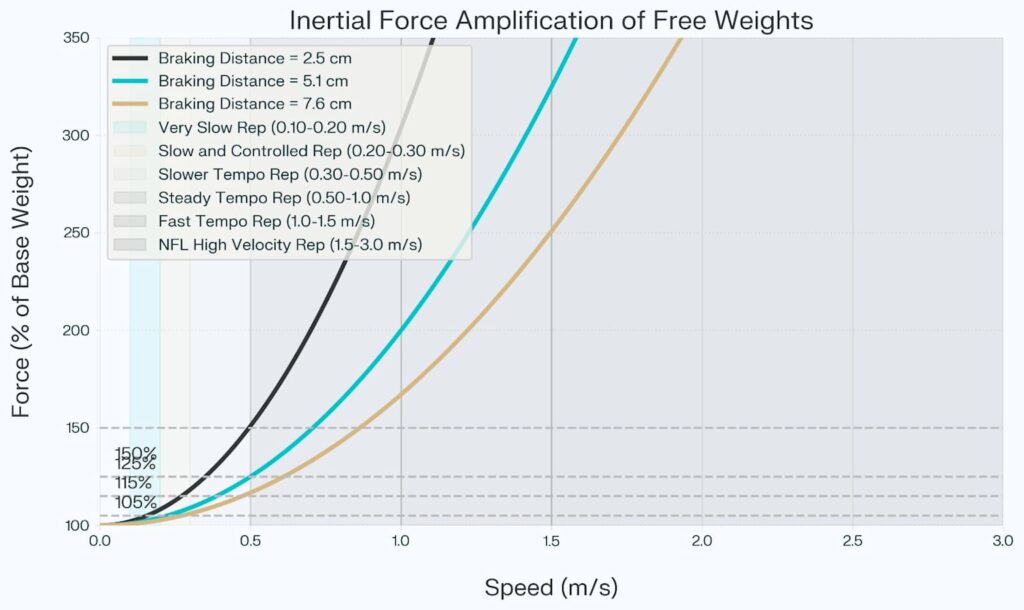The Hidden Danger
The Hidden Danger
Inertial Force Amplification in Resistance Training
Understanding the Force Multiplication Effect

As shown in the graph, when you move a weighted barbell at what feels like a controlled speed (0.5-1.0 meters per second or “steady tempo”), the force required to stop that weight in the final inch of the movement isn’t just the 200 pounds you loaded on the bar—it actually spikes to approximately 300-600 pounds (150-300% of the static weight).
If that gets to your head by sounding like a good thing to you, please keep reading as we explain why it’s not below.
The Hidden Danger of Inertial Force Amplification in Resistance Training
The above graph illustrates a critical phenomenon in resistance training that many lifters overlook: inertial force amplification during deceleration. This physics principle reveals why traditional free weights can create unexpected stress on your joints and tissues.
This force amplification occurs due to basic physics: an object in motion wants to stay in motion. When you decelerate a moving weight over a short distance, you create a force spike that significantly exceeds the weight you’re actually lifting.
The Timing Problem: Too Brief for Adaptation
What makes this particularly problematic is the duration of this braking event:
- At steady tempo speeds (0.5-1.0 m/s), when stopping over just 1 inch, the braking phase lasts only 0.025-0.051 seconds.
- This timeframe is far too brief for proper piezoelectric signaling, which requires sustained loading of approximately 0.1-0.25 seconds.
Piezoelectric signaling—the electrical signals in bones and tissues that trigger adaptive responses—needs time to activate the complete cellular cascade. Without sufficient duration, these brief force spikes register more as impact trauma than constructive stimulus.
The Nervous System’s Defensive Response
When joints experience these rapid force spikes, especially at biomechanically disadvantaged positions (like deep in a squat or at the bottom of a bench press), the body’s protective mechanisms activate1:
- Neural Inhibition: Your nervous system actively prevents you from recruiting maximum muscle fiber to protect joint structures
- Adaptation Interference: Instead of triggering growth pathways, your body initiates protective responses that actually -prevent optimal adaptations
- Movement Compensation: Your body develops subtle alterations to movement patterns to avoid pain or vulnerable positions
- Degenerative Tissue Responses: Most concerning are the negative reactions that occur after workouts:
- Scar tissue accumulation around repeatedly stressed joints
- Degenerative tendon changes from repeated microtrauma
- Joint inflammation and breakdown over time
- Bone stress responses that create long-term structural problems
The Cumulative Effect
What makes this particularly insidious is the cumulative nature of these responses. A single workout might not produce noticeable damage, but over months and years, these repeated force spikes in vulnerable positions can lead to:
- Chronic tendinopathies that don’t respond to rest
- Premature joint degeneration
- Diminished range of motion
- Persistent inflammatory responses
- Reduced training capacity over time
Why This Matters for Your Training
Understanding this inertial force amplification and its relationship to neural protection responses explains why many lifters eventually hit plateaus or develop nagging injuries despite using “proper form.” The physics of traditional resistance training creates these force mismatches regardless of technique1.
This is particularly relevant for exercises involving rapid deceleration at end ranges of motion, where joints are already most vulnerable to stress. The body’s protective mechanisms, while designed to prevent immediate injury, can actually interfere with long-term progress and joint health when combined with brief spikes in force.
Systems Relying on Inertial Properties
The following training systems all rely on inertial properties and therefore create the force amplification problems illustrated in the graph:
Free Weights
- Barbells and dumbbells (highest risk due to direct loading on joints)
- Kettlebells (provide some swing slack but still create abrupt braking forces)
- Weight plates and weighted implements
- Ankle weights and wrist weights (create particularly dangerous force leverage on smaller joints)
Machine-Based Systems
- Plate-loaded machines with weight stacks
- Smith machines and guided barbell systems
- Leverage machines with weight-based resistance
- Cable machines with weight stacks
Flywheel-Based Systems
- While you might think Flywheels solve for inertial/momentum properties more completely – we have a separate page discussing flywheel-systems
- Flywheel training devices (often create similar force profiles during braking)
- Inertial exercise equipment
- Most commercial rowing machines with flywheel resistance
- Spin bikes with heavy flywheels for resistance
Impact and Ballistic Equipment
- Medicine balls (create ballistic force with rubbery impact rebound)
- Slam balls and weighted throwing implements
- Plyometric equipment using body weight and gravity
- Impact-based training tools
Hybrid Systems
- Band-weighted combinations (bands plus weights)
- Chain-based variable resistance plus weights
- Pulley systems with inertial weight components
- Digital resistance systems that simulate weight properties
All these systems share the fundamental physics problem illustrated in the graph: as speed increases, force amplification during braking creates disproportionate loads at precisely the positions where the body is least capable of handling them safely.





Hi, this is a comment.
To get started with moderating, editing, and deleting comments, please visit the Comments screen in the dashboard.
Commenter avatars come from Gravatar.